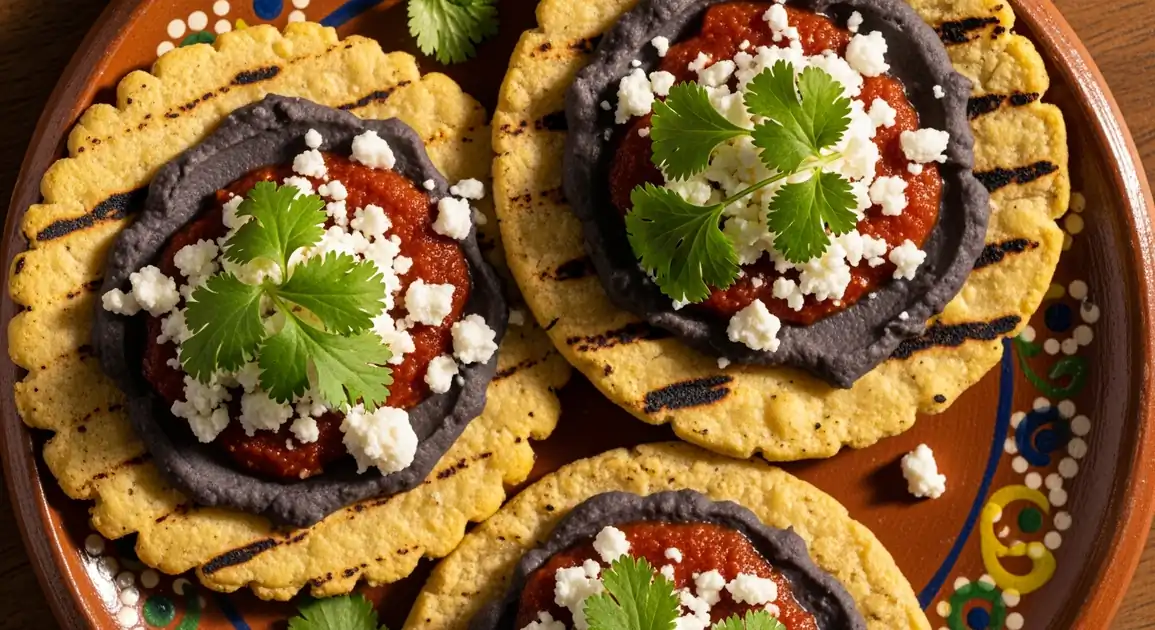Memelas
Memelas

Description
Oaxaca is the spiritual home of memelas, where they're an essential part of the culinary landscape. In Oaxaca City and surrounding villages, memelas are a breakfast staple sold by vendors who often specialize in this single dish, perfecting their craft through generations. The Oaxacan version - with its signature asiento (pork fat), black bean paste, and quesillo or queso fresco - is considered the definitive preparation.
Dietary Information
Serving information
Serving style
In Oaxaca, traditionally served on small plates, banana leaves, or simple paper. Accompanied by red and green salsas, often with a side of pickled vegetables (escabeche). Sometimes served with a small bowl of consome (broth) on the side.
Quick facts
Most traditional vendors operate 6 AM - 1 PM. Some market stalls continue until 3 PM or 4 PM. Evening options are more limited but available at certain restaurants and night food stalls.
Safety Tips
What to Look For
-
Fresh masa being prepared or formed by hand
Fresh masa ensures both better flavor and lower risk of contamination compared to masa that's been sitting out.
-
Hot, active comal (griddle) with sizzling food
A properly hot comal ensures thorough cooking, killing potential pathogens. The griddle should be hot enough that water would instantly sizzle.
-
Memelas cooked to order
Freshly cooked memelas are safest. Avoid places where premade memelas sit out for extended periods.
-
Clean preparation area with separated ingredients
Toppings should be in clean containers, ideally covered or refrigerated, especially cheese and prepared salsas.
-
Vendor using separate utensils for handling raw masa versus cooked food
This demonstrates good food handling practices and reduces cross-contamination risk.
What to avoid
-
Pre-made memelas sitting at room temperature
Memelas should be freshly made and served hot. Those sitting out can harbor bacteria.
-
Lukewarm or cool comal/griddle
Food safety depends on proper cooking temperatures. A griddle that's not hot enough won't properly cook the masa.
-
Unsanitary handling of money and food without handwashing
Look for vendors who either have separate people handling money or who wash/sanitize hands between handling money and food.
-
Visibly dirty preparation surfaces or utensils
Overall cleanliness is a good indicator of food safety practices.
-
Prepared toppings sitting unrefrigerated for long periods
Especially with cheese and salsas containing raw vegetables, refrigeration is important for items not being actively used.
Price information
Price range
Budget tips
- Local markets like Central de Abastos offer memelas for 10-15 MXN each.
- Small street stalls in residential neighborhoods are usually cheaper than those in Zócalo or tourist areas.
- At traditional morning vendors, two memelas (15-30 MXN total) make a satisfying, affordable breakfast.
- Adding specialty toppings or ordering in tourist restaurants can push prices to 25-35 MXN each.
Value indicators
- Handmade with properly formed edges (not machine-pressed).
- Cooked on-demand on a very hot comal.
- Made with freshly ground masa (some vendors grind their own corn).
- Generous amount of toppings and salsas.
- Properly toasted exterior with slightly charred spots.
Where to Find This Dish
Mercado 20 de Noviembre
Famous food market with multiple memela vendors in the food hall section.
Food hall area, Central market location
Morning, Afternoon
Mercado Benito Juárez
Traditional market with authentic food stalls serving memelas.
Food section upstairs, Interior food stalls
Morning, Early Afternoon
Central de Abastos
Oaxaca's largest market has numerous authentic, inexpensive memela vendors.
Food sections, Indigenous vendors' area
Early Morning, Mid-Morning
Tlayudas El Negro
Despite the name focusing on tlayudas, this popular night spot also serves excellent memelas.
Libres Market area
Evening, Night
Vendor Tips
- Look for women cooking directly on traditional clay comales for the most authentic experience.
- Vendors with a metate (grinding stone) or molino (grinder) visible are likely making fresher masa.
- Some of the best vendors sell out by mid-morning (10-11 AM) - arrive early!
- Street memelas vendors outside the Abastos market (especially on Saturday) are particularly good.
How to Order
Regional Variations
-
Blue Corn Memelas
(Memelas de Maíz Azul)
Made with blue corn masa, which has a slightly earthier flavor and distinct appearance. Common in Oaxaca's central valleys.
-
Market Style Memelas
(Memelas de Mercado)
The most traditional preparation, minimalist with just the basics - asiento, beans, cheese, salsa - but made with exceptional care and fresh ingredients.
-
Valley Memelas
(Memelas del Valle)
Variations found in Oaxaca's outlying valleys sometimes use different bean varieties or local ingredients like epazote or unique local cheese.
-
Breakfast Set Memelas
(Memelas con Desayuno)
Served as part of a breakfast set with eggs, beans, and coffee/chocolate - common at sit-down places in Oaxaca City.
Cultural context
History
Memelas have pre-Hispanic origins, dating back to ancient Mesoamerican cultures who developed nixtamalization (treating corn with lime) to create nutritious, workable masa. The name likely derives from Nahuatl, the Aztec language. For centuries, indigenous women in Oaxaca have prepared these simple corn cakes as an economical, filling food. While the base has remained relatively unchanged, the toppings evolved after Spanish colonization with the introduction of pork fat and cheese. Today, memelas remain a beloved traditional food and cultural touchstone in Oaxaca.
Local significance
In Oaxaca, memelas are more than food - they're a cultural institution representing indigenous culinary heritage, with techniques passed down through generations of women. They showcase the region's reverence for corn and connection to pre-Hispanic foodways.
Eating customs
- In Oaxaca, often eaten with chocolate de agua (water-based Oaxacan hot chocolate) or atole.
- Local custom is to add a little extra salsa after each bite.
- Often eaten in pairs as a complete meal, rather than as a side dish.